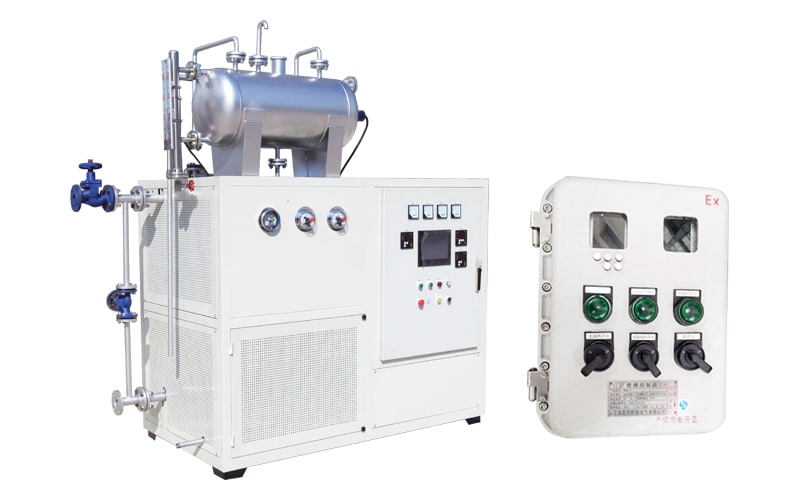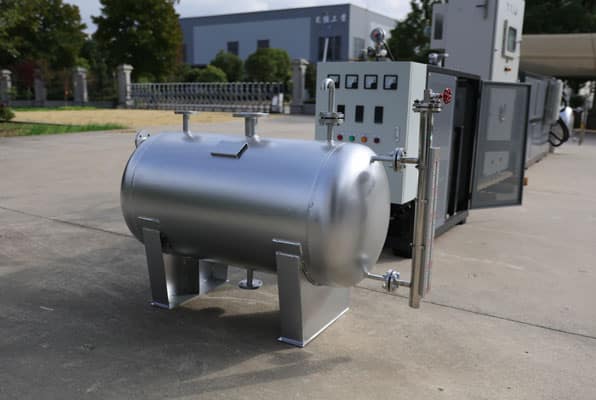1. Overview of the Expansion Tank
The expansion tank (also known as the expansion vessel) is an indispensable key component in electric thermal oil heating systems.https://8ruiyan.com/en/all-organic-heat-carrier-boilers/ It serves a dual role as both a “safety guard” and a “system regulator.” Functioning as the “breathing organ” of the thermal oil system, the expansion tank compensates for the volumetric expansion and contraction of the thermal oil due to temperature changes, ensuring stable system pressure. Additionally, it provides multiple functions such as gas venting, oil replenishment, and safety protection.

2. Structural Composition of the Expansion Tank
2.1 Tank Body
Typically constructed as a vertical or horizontal cylindrical container made of carbon steel or stainless steel. The capacity is determined based on the total oil volume of the system, generally not less than 1.2 times the total oil volume.
2.2 Auxiliary Systems
- Level Gauge: Used to monitor the oil level inside the tank, usually a magnetic level gauge or glass tube level gauge.
- Thermometer: Measures the temperature of the thermal oil in the tank.
- Overflow Pipe: Automatically discharges excess oil to the low-level storage tank when the oil volume is too high.
- Oil Replenishment Pipe: Used to add fresh oil to the system.
- Gas-Oil Separator: Removes and vents gases from the system.
- Nitrogen Sealing Device (Optional): Prevents oxidation of the thermal oil.
- Electric Heating Device (For Cold Regions): Prevents solidification of thermal oil at low temperatures.
2.3 Connecting Pipes
Include expansion pipes, overflow pipes, oil replenishment pipes, and gas venting pipes. All pipes are flanged and equipped with necessary valves.

3. Importance of the Expansion Tank
3.1 Volume Compensation
Thermal oil can expand by 20%-30% during heating. The expansion tank provides buffer space to prevent excessive system pressure.
3.2 Gas Venting
Removes gases generated during oil filling or system operation, ensuring no airlocks in the system.
3.3 Safety Protection
In case of sudden power failure or system malfunction, the expansion tank supplies cold oil to prevent overheating and coking of the thermal oil.
3.4 System Stability
Maintains stable system pressure, avoiding pressure fluctuations that could damage pumps and heating equipment.
3.5 Oil Protection
Reduces contact between thermal oil and air through nitrogen blanketing or temperature control, slowing oxidation.
4. Installation Position Requirements
4.1 Height Requirements
The expansion tank must be installed above the highest point of the system, typically:
- The minimum oil level should be 1.5-2 meters above the highest heat-using point.
- Generally installed at a height of 6-8 meters above the ground.
4.2 Location Selection
- Preferably close to the heater to minimize expansion pipe length.
- Installed indoors or with weatherproofing measures.
- Positioned for easy observation and operation.
- Avoid corrosive gases and dusty environments.
4.3 Space Requirements
- At least 0.8 meters of operating space around the tank.
- More than 1 meter of clearance above for maintenance.
5. Installation Technical Requirements
5.1 Pipe Connection Standards
- Expansion Pipe Connection: Extends from the system’s highest point, no valves, diameter not less than DN40.
- Overflow Pipe: Sloped downward to the low-level storage tank, diameter not less than DN50.
- Oil Replenishment Pipe: Equipped with a shut-off valve and filter.
- Vent Pipe: Leads to a safe area, no valves allowed.
5.2 Safety Requirements
- Lightning protection and grounding.
- Liquid level alarms (high/low level).
- Insulation or electric tracing in cold regions.
- Maintain safe distance from electrical equipment.
5.3 Material Requirements
- Tank material must be compatible with thermal oil.
- Sealing materials must be oil- and temperature-resistant.
- Insulation materials must be non-combustible or flame-retardant.
6. Operation and Maintenance Guidelines
- Initial Oil Filling: Slowly fill from the expansion tank while opening system vent valves.
- Daily Checks: Record liquid level and temperature daily, maintaining level between 1/2 and 2/3.
- Regular Maintenance:
- Monthly nitrogen pressure check (if nitrogen-sealed).
- Quarterly cleaning of the gas-oil separator.
- Annual inspection of tank corrosion.
- Troubleshooting:
- Sudden drop in liquid level: Check for leaks.
- Continuous rise in liquid level: Check for contamination or oil degradation.
- Abnormal temperature increase: Verify system circulation.
7. Common Issues and Solutions
| Symptom | Possible Cause | Solution |
|---|---|---|
| High expansion tank oil temperature | Clogged or undersized expansion pipe | Inspect and clean the pipe; ensure proper diameter. |
| Severe liquid level fluctuations | Excessive gas in the system | Enhance venting; check pump inlet for leaks. |
| Oil overflow | Overfilling or abnormal oil expansion | Adjust oil level; check oil quality and system temperature. |
| Rapid nitrogen consumption | Poor sealing or system leaks | Inspect nitrogen system; repair leaks. |
8. Conclusion
As the “heart” of an electric thermal oil heating system, the expansion tank’s proper design and installation are crucial for safe and stable operation. In practical applications, factors such as system size, operating temperature, and thermal oil properties must be considered when determining the tank’s capacity, position, and configuration. Regular maintenance and correct operation not only extend equipment lifespan but also improve energy efficiency and ensure production safety.
For technical inquiries, contact Ruiyuan’s official support team!
📞 📞 📞
Whatsapp:86-19106101570
wechat:86-19106101570
email:nieyili@cnryan.com
